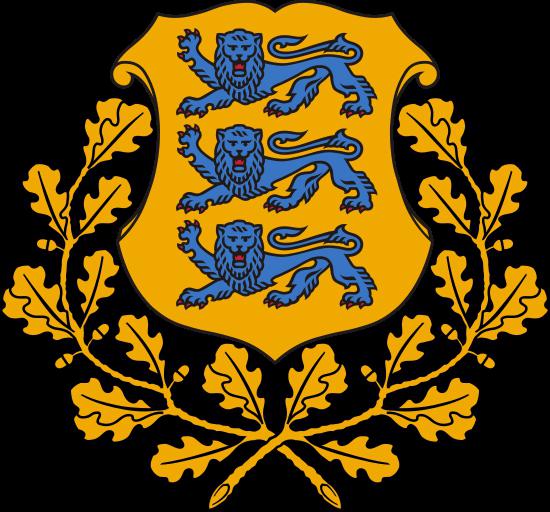As in other countries, considerable attention is paid to state symbols in Estonia. It is saturated with history and culture, various laws and rules are associated with it. Together with the anthem, the flag and coat of arms of Estonia are used on holidays for the country and on other special occasions. What is the meaning of state symbols? How did it come about?
What does the Estonian flag look like?
As in most other countries, in Estonia the panel has a rectangular shape with a classic length to width ratio of three to two. It is represented by three horizontal stripes of the same size. The top is blue, the center is black, and the bottom is white. The exact shade of the blue flag of Estonia is stipulated by law.
What do the stripes mean?
Each part of the flag has a separate meaning. They symbolize the nature and folk costumes that characterize Estonia. The flag also tells the story of the state. So, the blue color is intended to symbolize faith and devotion, in addition, it depicts lakes and the sea. Black denotes the suffering of the people in the past and the traditional outfit of local peasants. White indicates the pursuit of virtue, personifies hope and freedom. It also reminds of birch bark, snow, Estonian bright nights. In addition, all together the stripes resemble the Estonian winter landscape - snow, dark trees and the bright sky above them.
Flag History
In 1905, Estonia, whose flag served as a symbol of independence, tried to achieve sovereignty. In November 1918, the country succeeded, and the banner was approved. But independence from Russia was not too long. In June 1940, the country became part of the USSR, and the flag was banned for use. The situation continued until the collapse of the Soviet state. Independence was restored in August 1991, and Estonia returned to its own state symbols. The modern look of the flag was developed in December 1990, but the colors have remained unchanged from the very beginning of the century. Their combination arose as early as 1881. Students influenced the way the Estonian flag looks to this day. They decided to create a brotherhood and chose precisely blue, black and white as the colors of their association.
Student society "Vironia"
The history of the flag has its unofficial beginning in September 1881. Then the national student society “Vironia” was created, the first of all that Estonia knew. The flag of such an association, according to the charter, was to be a tricolor and not repeat the gamut of existing paintings. The Estonian symbol turned out to be very distinctive and recognizable. Three years later, six graduates and sixteen students from the University of Tartu gathered at Burchard Sperlingk, who was a pastor in Otepää. A priest named Rudolf Callas consecrated the tricolor. At the same time, students sang songs and made speeches about the symbolism and importance of the flag. The interpretation of Martin Lipp has become one of the most famous. But the existence of the Vironia corporation was not recognized by the current authorities, so the blue-black-white banner remained unofficial. Only after the Tsar’s manifest of October 17, 1905 did flags of this color appear on the streets. The Tartu Society organized a mass march, and Estonian students marched through the streets under the tricolor of Vironia. The flag was no less widespread than red panels in the spirit of the revolution.
National emblem

Other symbols that represent Estonia are worth mentioning. The flag, coat of arms and anthem are of equal importance to the country. Each of them is filled with history. The emblem is made in the form of a heraldic shield with a pointed bottom and rounded upper corners. On his yellow background are three blue lions. Such an image was previously the central symbol of the city of Tallinn. The Danish kings were entitled to use it to the city. Lions on the coat of arms depict strength, valor and nobility. The crown of the shield is a wreath made of oak branches and refers to the heraldic symbols of England and Denmark, with which Estonia is historically closely connected. The flag of the country is different from the banners of these countries, but the coat of arms, on the contrary, has much in common. In addition, there is a close relationship with Latvia. In the east, Estonia also borders with Russia, but the Estonian state has always sought in its cultural development towards Europe, so it is difficult to find common features in the symbolism of these countries.
Anthem of Estonia
Interesting facts also apply to the main melody that Estonia represents. The flag and coat of arms were created later than the anthem. It was based on a chorale called "My Fatherland, My Happiness and Joy!" The corresponding arrangement was performed by the German composer Frederic Patsius, who lived in Finland at that time. In Estonia, the verses of Johan Waldemar Jannsen, who was a significant poet of the national awakening of those times, were put on his music. For the first time, the resulting song was performed in 1869 at a singing festival. The growing popularity of the national movement also increased the relevance of the melody. In Finland, the song fell in love with students, but it was performed everywhere. After World War I, both countries gained independence and chose the melody as their national anthem. In Finnish, other verses are used. The song became the official anthem of Estonia after 1920, when the War of Independence ended. In Soviet times, the melody was banned along with the use of the flag and coat of arms of the country. The state was able to return to national symbols only after the collapse of the USSR.